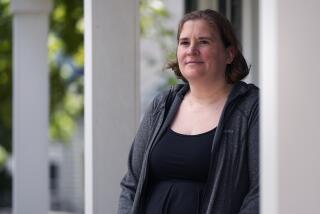Lunch Hour--What Lunch Hour?
- Share via
And at noon, God created lunch.
So it seems that since the beginning of time, that perfect hour between noon and 1 p.m. has been sacrosanct--a treasured time for food, conversation and a respite from the day’s demands.
It survived even while American workers, for the most part, paid their last respects some years ago to the boozy, smoky three-martini lunch and the tax-deductible repasts of grilled steaks and salmon cakes.
But now, the venerable tradition of lunching--even at its most essential--seems vulnerable, a victim of time, downsizing and the weighty concerns of an increasingly computer-shackled work force.
“What lunch hour?” sighs Donna Hubbs, a secretary at ITT Hartford. “I have two jobs, two kids, one with mental retardation, a pretty heavy workload here at The Hartford, my community activities, and a grandmother and mother-in-law in a convalescent home.
“I make phone calls and maybe grab a sandwich--you’ve just got to juggle it,” said Hubbs, who lives in Bloomfield, Conn., and also runs a travel agency with her husband.
Though lunch certainly hasn’t disappeared--people are still eating, and a lot of business is still being conducted over white linen and shiny flatware--it has been taking its knocks.
“It seems that people have less and less time these days between child care and extra pressures at work,” said Terry D’Italia, an Aetna spokesman. “Too many people are taking lunch back to their desks.”
D’Italia, who first had swapped eating at noon for running, recently dropped that regimen as too time-consuming.
“It meant I was away from my desk for one hour, 15 minutes,” he said. “I felt a lot of guilt.” Now D’Italia, more often than not, grabs a bowl of chili in the company cafeteria and spends a few minutes alone reading the newspaper before hustling back to his office.
*
What did you do yesterday for lunch? If you’re like a growing segment of workers, you ate something quickly at your desk, most likely a sandwich, while making phone calls, answering e-mail or cruising the Internet. Many of you ate behind the wheel of your car or delivery truck.
Some of you took a quick run or had a workout on the company treadmill. You may have buzzed around like a maniac, squeezing in as many errands as time and traffic would allow. More of you may be working a flexible schedule that means lunch has disappeared altogether.
Workers who feel pinched for time at lunch aren’t alone. A new nationwide survey by the National Restaurant Assn. found that 45% of employed adults feel they have less time for lunch than they used to, and more than 39% say they don’t take a real lunch break.
Restaurateurs, who suffered the recession and tax law changes that limited business meal deductions, are trying to put the best spin on the lunch crunch. Some are offering noontime meals in 30 minutes or less, and the national association is touting eating out as a perfect option--not an impossibility--for busy workers.
Cora Hedstrom, a mother of two who handles university relations for Emporia State University in Kansas, doesn’t claim to be an expert on national lunching trends. But here’s what she did during her noon hour recently: “I ran home, took out meat for dinner, switched a load of laundry, wrote a couple of invitations to a weekend barbecue, then headed to a gift shop to buy a shower gift.”
And at MiraCosta College in Oceanside, public information coordinator Lynn Pierce said she hasn’t taken a “normal, sit-down lunch hour for 11 years.”
“When I worked as a newspaper reporter, I was always too busy and ended up eating at my desk,” she said. “Now, at MiraCosta College, I use my lunch and coffee breaks to speed walk around campus.”
Then she’ll eat at her desk between phone calls and appointments.
*
Almost half of working women believe they have less time for lunch than in the past, compared with 40% of working men, the restaurant association survey found. Women also are more likely to report that they don’t take a real lunch break, or that they use their break to do something other than eating, research manager Karen Gardner reports.
And, the survey shows, men are more likely than women to eat lunch at a sit-down restaurant. Women are more likely to get a carryout lunch.
Experts in employee health shake their heads at lunch plans that don’t involve getting up and away from a desk or computer, or out from behind the wheel of a car or delivery truck.
“People need to get up and move around,” said professor Neil Schmottlach, director of the Fisher Institute for Wellness at Ball State University in Indiana. “They need a chance for a change of pace, and to socialize.
“Everyone should have an opportunity to regenerate at lunch hour,” said Schmottlach, whose institute is one of a handful in the country training people to manage wellness programs for industry, schools, communities and hospitals.
Professor David J. Schnall, management and workplace expert at Yeshiva University in New York City, is a strong lunch advocate and advises workers to leave the building and get outside.
It’s a stress issue, said Schnall. Workers need diversion, he said, a break from the hubbub, a time away from tedium.
“We should be encouraging employees to take lunch, to get out of the building, to take a walk, to have lunch on the street corner or in a park,” he said.
More to Read
Sign up for The Wild
We’ll help you find the best places to hike, bike and run, as well as the perfect silent spots for meditation and yoga.
You may occasionally receive promotional content from the Los Angeles Times.






